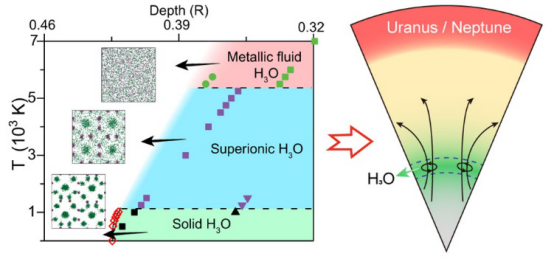Recently, Yanming Ma’s group in Jilin University reported progress in high pressure planetary physics. The results are published in PNAS on March 3, 2020, entitled “Stability of H3O at extreme conditions and implications for the magnetic fields of Uranus and Neptune” Proc. Natl. Acad. Sci. USA https://doi.org/10.1073/pnas.1921811117 (2020).
In the 1980s, data from NASA’s Voyager 2 probe have shown that the magnetic fields of Uranus and Neptune are different from those of other planets in the Solar System. Their fields are not predominantly dipolar, but also have a quadrupole component. In addition, the main axis of their fields is tipped over from the rotation axis by about 59° (49°) for Uranus (Neptune). The magnetic fields of planets are generated by dynamo action, in which conducting fluid is one of the essential ingredient. However, the material basis for the conducting fluid remain unclear.

The interiors of Uranus and Neptune are thought to be composed of 56% H2O, 36 CH4 and 8% NH3. Pressure and temperature conditions within the ice layer range from 20 GPa and 2000 K to 600 GPa and 7000 K, where CH4 becomes unstable and dissociates into C and H2. Accordingly, Yanming Ma’s group proposed that new H-O compound may generate in hydrogen-rich environment. They used their inhouse developed CALYPSO method for the prediction of H-O compounds at high pressure and surprisingly found stable H3O. Further simulations indicate that H3O may exist in the interiors of Uranus and Neptune as metallic fluid, providing material basis for the unusual magnetic fields.
PNAS is one of the four top journal (Cell, Nature, Science and PNAS) in the world, with a history of more than 100 years. The publications in PNAS include biology, chemistry and physics, and is one of the most cited journal.
Peihao Huang and Hanyu Liu from International Center for Computational Methods and Software in College of Physics are co-authors. The corresponding authors are Changfeng Chen (University of Nevada), Russell J. Hemley (University of Illinois at Chicago), Yanchao Wang (Jilin University) and Yanming Ma (Jinlin University). The work was supported by the National Natural Science Foundation of China, Science Challenge Project, Program for Jilin University Science and Technology Innovative Research Team (JLUSTIRT), High-Performance Computing Center of Jilin University and Tianhe2-JK at Beijing Computational Science Research Center.
